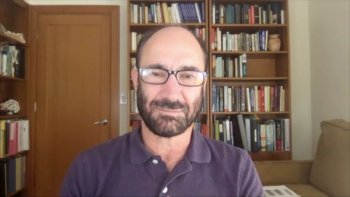
Michael Snyder, PhD, professor and chair of genetics at the Stanford University School of Medicine, discusses the ways in which precision health measurements can aid physicians in detecting and better managing diabetes.

Michael Snyder, PhD, professor and chair of genetics at the Stanford University School of Medicine, discusses the ways in which precision health measurements can aid physicians in detecting and better managing diabetes.

Pain is a subjective response with multiple features and components, said Frank Porreca, PhD, professor of pharmacology and anesthesiology at the University of Arizona and a member of the Department of Collaborative Research at Mayo Clinic in Arizona.

Despite limited resources to combat the coronavirus disease 2019 pandemic, collaborative efforts among the government, health plans, and providers in Puerto Rico exemplify how care can be better optimized in communities in the United States impacted by disparities in health care services.

Feedback from the field is incredibly important when participating in new payment models like the Oncology Care Model, said Basit Chaudhry, MD, PhD, founder of Tuple Health.

Decades ago, companies refused to heat-treat their blood products, which resulted in pooled plasma, among others, enabling many viruses to be transmitted, noted Robert K. Massie Jr, PhD, MA, of the Society for Progress.

The economics of cancer care remain a major concern as practices try to figure out how to deal with the cost of providing cancer care, said Sibel Blau, MD, medical oncologist, Northwest Medical Specialties, and president and CEO, Quality Cancer Care Alliance (QCCA).

Chimeric antigen receptor (CAR) T-cell exhaustion likely stems from chemotherapy prior to transplant, noted Michael R. Green, PhD, University of Texas MD Anderson Cancer Center.

Through neoadjuvant chemotherapy we can downstage tumors, assess drug efficacy, and better segregate women by prognosis status for adjuvant treatment, explained Alexey Aleshin, MD, senior medical director of Oncology at biotech giant Natera.

Matthew J. Zirwas, MD, a dermatologist in Ohio, discusses how dermatologists may stratify patients with atopic dermatitis (AD) with the launch of new biologic treatments in 2021.

There are several risk factors to review when determining whether or not a patient is high risk for lung cancer and should be screened, said Joanna Thompson, multidisciplinary program manager, Highlands Oncology Group.

Several economic benefits stem from engaging in care soon after HIV transmission and maintaining viral load suppression, noted Milena Murray, PharmD, MSc, BCIDP, AAHIVP, associate professor, Midwestern University College of Pharmacy.

Slowing progression of chronic kidney disease can help mitigate adverse outcomes in minority populations, said Guofen Yan, PhD, associate professor of biostatistics in the Department of Public Health Sciences at the University of Virginia School of Medicine.

This approach allows clinicians to keep using existing prediction models and incorporate chronic kidney disease (CKD) data seamlessly to calibrate patients' risks, said Kunihiro Matsushita, MD, an associate professor in the Department of Epidemiology and Division of Cardiology at Johns Hopkins University.

In 2020, the top 5 most-watched interviews published on AJMC.com addressed a myriad of different issues within breast cancer, cardiology, and HIV, with additional perspectives on the coronavirus disease 2019 pandemic.

One guideline focuses on managing severe asthma and the other begins with recommendations for mild intermittent asthma before increasing based on disease severity, noted Megan Althoff, MD, PhD, University of Colorado.

Our 5 most-read oncology stories and most-watched videos this year highlighted cancer care policy, diversity, and the growing practice of remote cancer care.

Robert Baird, RN, MSA, president of the National Cancer Treatment Alliance, discusses ways that employers of all sizes can pursue direct contracting with health care providers.

During the panel on precision medicine at the Quality Cancer Care Alliance (QCCA) Fall Leadership Summit, the speakers discussed testing every patient upfront with a broad molecular assessment and bringing clinical research to the patient.

Wayne Jonas, MD, executive director of Samueli Integrative Health Programs at H&S Ventures, discusses what new therapies are emerging in the world of pain management.

There is a lot of variation among commercial payers, but broadly speaking they are expected to start moving to adopt what Medicare does, said Basit Chaudhry, MD, PhD, founder of Tuple Health.

Practices deciding whether to join Oncology Care First or another oncology alternative payment model (APM) will need a clear understanding of how big of a transformation they’ll need to make to their practice, said Mike Fazio.

Researchers are studying the blood of Robert K. Massie, Jr, PhD, MA, Society for Progress, who was born with severe factor VIII hemophilia and contracted HIV and hepatitis C from contaminated blood products. He did not require antiretrovirals until undergoing a liver transplant a decade ago.

When evaluating a patient’s response to a biologic for asthma, factors to consider include patient preference, safety, and symptoms, explained Nicola Hanania, MD, MS, pulmonary critical care physician and director, Airway Clinical Research Center, Baylor College of Medicine, Houston, Texas.

Robert Baird, RN, MSA, president of the National Cancer Treatment Alliance, discusses potential issues employers can avoid by direct contracting with providers.

When it comes to the next steps for anti-CGRP therapies, we need to discuss the concept of synergism, said Stephen Silberstein, MD, professor of neurology at Thomas Jefferson University and director of the Headache Center at Jefferson Health.

Clarence Moore, PharmD, BCPS, BCOP, assistant professor at Shenandoah University in Ashburn, Virginia, discusses whether treatment methods for beta thalassemia are accessible to patients.

Wayne Jonas, MD, executive director of Samueli Integrative Health Programs at H&S Ventures, discusses what foods he recommends including and excluding from patients' diets to help manage pain.

Bradley Monk, MD, FACOG, FACS, clinician at Arizona Oncology, professor at the University of Arizona and Creighton University in Phoenix, discusses the reimbursement of PARP inhibitors in ovarian cancer.

The treatment landscape for atopic dermatitis is beginning to change from the use of topical therapies to biologics and more, said David Pariser, MD, senior physician at Pariser Dermatology Specialists and professor at Eastern Virginia Medical School Department of Dermatology.

Patient plasma samples from this study show residual circulating tumor DNA (ctDNA) correlates with a poor prognosis in women with early-stage breast cancer, explained Alexey Aleshin, MD, senior medical director of Oncology at biotech giant Natera.

259 Prospect Plains Rd, Bldg H
Cranbury, NJ 08512
© 2025 MJH Life Sciences®
All rights reserved.
